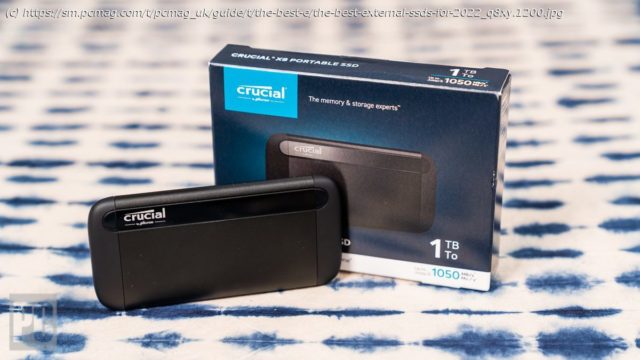Dump that poky portable hard drive! External solid-state drives are faster and more affordable than ever. Check out our top-rated SSDs, plus detailed advice on how to buy the right one for you.
Need to expand the local storage on your PC or Mac for music and movies, or all the pics and videos you collect from your phone? The traditional answer has been an external hard drive. The newer, better one is a portable solid-state drive (SSD).
Once prohibitively expensive, SSDs of all stripes, internal and external, have plunged in price over the past few years. Nowadays, pocket-size, USB-powered external SSDs deliver as much as 10 times the speed of portable hard drives, and much greater durability. They have no metal platters to spin up, nor any read/write heads that need to travel to a specific point on a platter to find the file you need. And a lack of moving parts makes mobile SSDs smaller, slimmer, and better suited to frequent travel and accidental drops than even ruggedized hard drives.
Below, check out our favorite models we’ve tested from all our recent SSD reviews. Then read on for a detailed guide to how to shop for the portable SSD that best meets your needs. We’ll finish this guide with a spec breakout of all of our top picks.
As you can see above, there’s a wide variety of portable SSDs to pick from. As you shop, you’ll need to pay attention to capacity, size and weight, and a drive’s interface or connection to your PC, as well as whether you need one with a rugged casing.
First: Here’s why you want an SSD versus a hard drive. Unlike a hard drive, which stores data on those spinning platters accessed by a moving magnetic head, a solid-state drive uses a collection of “persistent” flash memory cells to save data. These are similar to the silicon that makes up a computer’s RAM, but they retain your data when electrical power is cut off.
Since hard drives are mechanical devices that use mature technology, you can get relatively large amounts of storage capacity for the money. But the same tech that makes hard drives a tantalizing value becomes their biggest liability when used on the go. If you drop the drive, you could damage the interior mechanism and make your data inaccessible. By contrast, if you jolt an SSD while you’re reading or writing data, there is no risk that your files will become corrupted and unreadable.Is an External SSD Faster Than an External Hard Drive?
Yes: Again, hard drives are slower because they have to physically access your data. Just how much faster is it to read data from flash cells than from particular points on spinning platters? Typical throughput for consumer hard drives is in the range of 100MBps to 200MBps. (One factor is spin rate—among external drives, 5,400rpm units are more common and more affordable than 7,200rpm.)
Our typical benchmark-test results for even run-of-the-mill external SSDs show speeds in excess of 400MBps. Practically speaking, this means you can move gigabytes of data (say, a 4GB feature film, or a year’s worth of family photos) to your external SSD in seconds rather than the minutes it would take with an external hard drive.
Still, you do pay for that speed and durability. Want a 2TB portable hard drive? You can find one from major brands such as Seagate and Western Digital for as little as $60. A 2TB external SSD, on the other hand, will run you about $250 to $300. You’ll pay four or five times as much for the same amount of storage. If speed, resilience, and portability are critical to you, all that extra money is probably worth it. If they’re not, proceed with care. When considering whether to buy an external SSD, make sure you know what you’re paying a premium for.
External SSDs are now readily available and cheaper than they were a few years ago, but it will probably be a while before they are a complete replacement for hard drives. Physically larger external drives designed to stay on your desk or in a server closet still mostly use 3.5-inch platter drives inside, taking advantage of their higher capacities and much lower prices per gigabyte compared with SSDs.What Is the Best External SSD Interface?
External solid-state drives are, essentially, internal SSDs (the same kind that power laptops or live inside desktops) with an outer shell and some bridging electronics. As a result, external drives use one of two internal “bus types” that, in part, dictate their peak speed: Serial ATA (SATA), or PCI Express (PCIe). The latter is usually associated these days with Non-Volatile Memory Express (NVMe), a protocol that is optimized for the characteristics of SSDs and speeds up data transfers.
SATA-based drives tend to be a little cheaper; they’re also slower, but just fine for most users’ everyday applications. SATA-based SSDs typically top out at around 500MBps for peak read and write speeds, just a bit below the ceiling of the USB 3.0 interface. (Much more about that in a moment.) However, if you’re going to be transferring large files such as videos often, you may well want to spring for a PCIe/NVMe-based external SSD. That also ties in with the port you’ll plug your SSD into.
Sellers of portable SSDs seldom indicate if the drive is SATA- or PCIe-based. However, checking the specs can be a dead giveaway. If the drive tops out at sequential read and write speeds between 400MBps and 550MBps, it’s very likely SATA-based. Speeds of 800MBps or higher indicate a PCIe-based drive.






